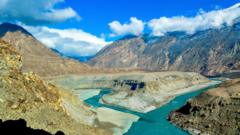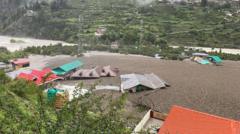The article investigates the implications of India's suspension of the Indus Waters Treaty and the feasibility of water manipulation.
**Can India Manipulate Water Flow to Pakistan Amid Rising Tensions?**

**Can India Manipulate Water Flow to Pakistan Amid Rising Tensions?**
As India suspends a crucial water-sharing treaty with Pakistan, questions arise about water control in the Indus basin.
In recent developments, the question of whether India can effectively halt the flow of the Indus River and its tributaries into Pakistan looms large, especially following India's suspension of the Indus Waters Treaty (IWT) after a violent attack in Indian-administered Kashmir. This agreement, established in 1960, had endured significant geopolitical tensions and was aimed at managing water resources shared between the two nuclear powers.
The suspension signifies heightened tensions, as India accuses Pakistan of supporting terrorism, a claim vehemently denied by Islamabad. While India asserts the right to reconsider the treaty due to shifting needs from water scarcity aggravated by climate change, Pakistan views any attempt to control river flow as a declaration of war. Historically, the treaty allotted three eastern rivers—Ravi, Beas, and Sutlej—to India and the remaining western rivers—Indus, Jhelum, and Chenab—to Pakistan.
Tensions over water have surfaced intermittently, with Pakistan objecting to India's river projects, asserting they threaten the flow and violate treaty stipulations. Given that over 80% of Pakistan's agricultural and hydropower resources depend on the Indus basin, this situation is critical.
Experts contend that India's capability to fully stop or divert the flow of western rivers during peak flow periods is limited due to inadequate infrastructure. As noted by Himanshu Thakkar, a water resources expert, India's existing hydropower infrastructure does not support massive water storage or diversion efforts. Consequently, India has yet to fully utilize its allocated share of water from the treaty, which has led to calls for improved storage facilities—something that Pakistan opposes for treaty-related reasons.
While India does have the option to enhance its infrastructure for potential water control without notifying Pakistan, challenges such as geographical constraints and domestic opposition have hindered significant progress in construction. Historical actions, such as those taken after the 2016 militant attack, revealed promises to expedite dam constructions which show little progress in reality.
Disputes may intensify further during the dry season, which could exacerbate water shortages in Pakistan if India begins to control flow actively. Notably, the IWT necessitates hydrological data sharing, vital for managing irrigation and drinking water, which India can now limit without formal repercussion, potentially affecting flood forecasts in Pakistan.
Compounding the situation, concerns surrounding the weaponization of water remain relevant. Although immediate flooding risks on Indian soil could deter such actions, India could still cause downstream damage by unexpectedly releasing silt accumulated in reservoirs.
This condition is reflective not only of South Asian dynamics but also of the regional interplay with China, which has its own ambitious water projects in Tibet affecting the Brahmaputra, highlighting the increasingly complex geopolitics surrounding water in the region. As this situation unfolds, both countries remain on high alert regarding the potential ramifications for water security and international relations.



















